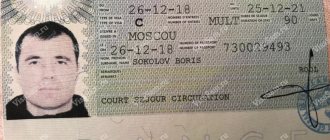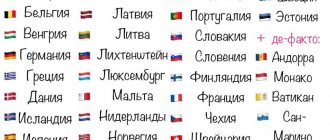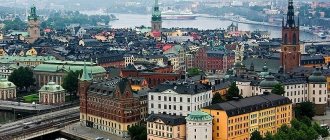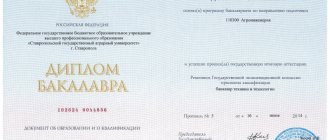Schengen visa refers to permitting documents. A person receiving a visa has the right to enter and leave a foreign country, to stay on its territory for a certain period of time, including as part of a transit flight.
The Schengen visa deserves special attention - it is valid on the territory of a large number of European countries that have signed the agreement of the same name. If a Russian citizen wants to visit Europe, he will have to obtain a tourist permit.
Answers to the main questions about the Schengen visa
If you have never been to Europe or have never crossed the borders of other countries, you should know the following:
- The rule of first entry into Schengen does not apply - it simply does not exist. Read more in our article “Rule of first entry into Schengen 2021“, but for now let’s clarify briefly: if you plan to travel to several European countries, then obtain a visa at the consulate of the state of your main destination. Determine it by the number of days of stay or the purpose of the trip. The country of entry does not matter. For example, if you have a tour of France (3 days), Spain (7 days) and Portugal (4 days), then you need to contact the Spanish consuls. This is because you will spend the most time in Spain (e.g. Madrid). If you want to stay in two countries for the same period of time, choose either one. For example, when visiting Belgium and Germany for 8 days (4 days each), you can contact either the Belgians or the Germans. It is better to cooperate with the consulate where it is easier and faster to obtain the document you need.
- Contrary to popular belief, border guards, not customs officers, are responsible for checking documents. Although there are exceptions to the rule: in some countries, it is customs officers who can request both a passport and a visa. We are talking about Slovaks, Swedes, Norwegians and Finns. This is also practiced in Hamburg, Bavaria and Bremen. In most cases, customs officials check exported and imported goods and look for unauthorized weapons and drugs. A lot of cash can attract the attention of employees. As for passports, they are checked exclusively by border guards and no one else.
- The Schengen Agreement covers 26 countries. Data is current as of January 2021. When answering the question of why a Schengen visa is needed, pay attention to the scale of opportunities that you get when you apply for the document: a person receives the right to freely move around more than two dozen countries. The easiest way to apply for a Schengen visa is to six countries, a list of which can be found in our article.
Although initially there were only 7 countries among the Schengen states. They signed an agreement that came into force in 1995. The first were the French, Spanish, Germans, Belgians, Portuguese, Dutch and Luxembourgers. A couple of years later the Italians and Austrians joined them. In 2000, Greece joined the Schengen countries. A year later, the list increased by another 5 states. Later, part of the Baltic states and a number of other states were included in the list. The result was 26 members.
It is worth paying special attention to the countries shown on the map of Europe: Ireland, Croatia, Cyprus, Bulgaria, Macedonia, Great Britain and Romania - they are not part of Schengen. Again, this information is current as of January 2021.
Self-guided process for obtaining nonimmigrant visas
- Check the list of required documents to obtain a visa,
- print out the consular form,
- collect the necessary package of documents,
- fill out the form,
- pay the consular fee,
- submit documents to the Embassy to obtain a visa.
It must be remembered that as the flow of citizens applying to embassies increases, the number of refusals to receive them also increases.
Violation of the visa regime entails refusal to obtain a visa the next time.
What Schengen visas are there?
There are 6 categories of visa documents:
- A. A person receives the right to stay in the transit zone, which is located on the territory of a Schengen country. Typically, this type of visa is issued to citizens of Iraq and some CIS countries. Russian residents need such a document in exceptional cases, for example, when flying from Georgia or Turkey. Some routes pass through French airports.
- Q. Currently there is no such visa. Previously, it provided the right to regular transit for no more than 5 days. In addition to the possibilities mentioned in the first option, a person freely left the airport to the arriving city, and then boarded the flight again and continued the trip to the destination. If you want to get these rights now, you will have to apply for a regular visa.
- Schengen visa type C. The most common document. People apply for it for tourist, guest, business and transit trips. Citizens with this type of visa do not receive the right to work.
- D. Long-term national visa (more than 90 days in Schengen territory within six months). Since April 2010, the document’s capabilities have been reduced and are equal to option C (in particular, the total period of stay is 6 months).
- LTV (in Spain – VTL). A person receives the right to stay, transit or enter only certain Schengen countries. This visa is rarely issued, in exceptional cases.
- FTD or FRTD . A transit document issued in a simplified manner. Its action is strictly limited. A person receives the right to transit along the route Kaliningrad region - another part of Russia and back. Transit traffic by land through Lithuania. If we are talking about railway transport, a citizen of the Russian Federation does not have the right to leave the railway station.
Thus:
In 99% of cases, when applying for a Schengen visa, you will receive a type C document.
Long-term visas
All long-term visas are authorization for stays exceeding 91 days, up to several years. You can obtain a long-term visa only if there is sufficient justification for the purpose of the visit and if they do not contradict the established rules. As an example, we can highlight guest visas for visiting relatives for a long period, work visas, permits for studying at schools, colleges, and universities.
Guestbook
A long-term visitor visa most often involves visiting relatives or close friends for a period of up to several years. In this case, an invitation is required and, if necessary, sufficient justification and confirmation of family ties between the inviting party and the invitee.
In the Schengen zone, a visa with type D can act as a long-term guest visa. It confirms permission to visit a particular country in the Schengen zone, therefore it is also defined as national. In most cases, it still allows you to visit other Schengen countries, but only one important rule remains - the country of first entry into the Schengen zone with such a visa must be the one for which it was issued.
Working
To officially register hired labor abroad, you must obtain a work visa. This visa is a residence permit for the entire duration of the employment contract or agreement. It makes no difference whether it is attracting a highly qualified professional or a seasonal handyman, to obtain such a visa, an invitation is required from the company in which the invitee intends to work. Only if you intend to look for a job should you provide a letter from the local chamber of commerce or proof of career guidance and experience that is in demand in the target region.
Work visas are almost always distinguished by the nature of employment. For example, in the case of the Schengen area, they can fall into three main categories regarding the rules of Poland:
- D-15 – issued for professional activities or for work in sought-after positions;
- D-07 – seasonal work in agriculture.
In other countries, work visas may differ, given the current labor market situation.
Student
To study at foreign universities, students are issued a student or study visa, which allows them to stay in the country for the entire period of study and, in some cases, as with a multiple visa, to cross the border several times. To receive it, you must submit supporting documents indicating that the educational institution is ready to accept a foreign student. The validity of the visa may cover the entire period of study or only part of it, for example one semester. In the second case, it will be necessary to constantly renew the permit, provided that there are no claims from the university against the student.
Along with study visas, you can also get a guest visa, designed to accompany the student’s parents or visit him while he is studying.
What other countries can you visit if you have received a Schengen visa?
It’s strange, but lucky holders of a Schengen visa can visit not only the twenty-six Schengen countries, but also several others. Here's where else you can go with this visa:
- Albania. You need a visa category C (multiple entry) or D. You can replace it with a residence permit.
- Bulgaria. The conditions are the same as when visiting Albanians. The 90 day rule also applies. You can stay in the country for six months, but not more than this period. Every 6 months the count starts from zero.
- Gibraltar. A C visa is required, which allows multiple entries. You cannot stay in Gibraltar for more than 21 days. If the visa document expires before 21 days have expired, the period of stay is calculated using the formula: 1 week is subtracted from the remaining days of the visa validity.
- Cyprus. Category C. If double or multiple trips are allowed, you must first enter the Schengen territory and then Cyprus. If you have a one-time right to visit the country, enter the island from Schengen states. There are no separate time limits, as there are when traveling to Gibraltar.
- Costa Rica. Here, on the contrary, there are no requirements for the type of visa document. But the period must be less than 3 months, starting from arrival in Costa Rica.
- Panama. You must have a visa from a country that is a member of the EU. Visiting the state is permitted with a double or multiple entry visa. First you must visit the country whose consulate issued the document.
- Reunion . Look at the visa sticker. If it says “also valid for Reunion”, you can visit the French region.
- Romania . You can come to the country with a visa (category C) with double/multiple entry to Schengen or a residence permit. You can stay in Romania for as long as indicated in the permit document. The general rule of 6 months applies.
- French Guiana . This overseas region is open to tourists as long as they have the entry “also valid for French Guiana” on their visa sticker.
- Croatia . To be in the republic, you need to get a visa C, D. A residence permit is also suitable. To determine how long you can stay in the country, refer to the time limits in the Schengen document. But every 180 days you are allowed to stay in the countries of the agreement for no more than 90 days.
The figure shows countries that can only be visited with a Schengen visa. They are highlighted in blue. There are quite a lot of them. The consulates of these states are engaged in issuing permits. Citizens of the Russian Federation can visit some visa countries if they have a Schengen visa. But this issue requires more careful consideration.
Green color corresponds to countries where people with Russian citizenship can travel freely. In some countries, it is enough to present an internal passport, for example, when traveling to Belarus. In others, you will be required to provide a foreign passport.
The rest of the territory that does not fit into the above groups is highlighted in grey.
Please also pay attention to such concepts as the EU, euro area, Schengen. These are different concepts that have significant differences. If a country is a member of the European Union, it is not necessarily included in the list of Schengen states and vice versa. Combinations can be very different.
And one more thing: Switzerland, Iceland, Liechtenstein, Norway are not part of the customs union. If you cross the border with them, moving from Germany for example, be prepared for customs control. You will be asked to declare and, if necessary, present the cargo being transported. It is interesting that the above countries are part of the Schengen zone, you can enter there with a visa of the same name - there is simply additional control.
Visas and visa-free regime
If we talk about citizens of Russia and the CIS countries, it is easier to say which countries do not require a visa than to list all the countries that require a visa. Today, most questions among tourists arise regarding visas for travel to the countries of the European Union and the United States.
All countries have almost the same visa process. For each, you need to provide a guarantee of return to your homeland, confirm solvency and availability of reservation or housing in the country, take a photograph in the prescribed image and pay a consular fee. However, each country and each visa type has its own differences.
What rules apply to a Schengen visa?
- Are there any other territories that are not a Schengen area or have a special status? These countries include Andorra (formally, a visa is not required, but you can only get here through France or Spain, which means you can’t do without a double or multiple visa); Vatican (the status of the state is unclear; checks are not carried out at the borders); Liechtenstein (since the end of 2011, part of Schengen, entry rules are the same as in Switzerland); Monaco (when crossing the French border, a joint agreement between these two states applies); San Marino (to enter here, follow the rules for visiting Italy).
- Is a Schengen visa valid when visiting the UK? The document is not valid because the British Kingdom pursues an independent policy on immigration issues. The rule also applies in the opposite direction. If you have received permission to enter Ireland, it is not valid in the Schengen countries.
- Is it possible to get to Bulgaria and Romania with a Schengen visa? It is forbidden. On the territory of these states, different rules apply.
- What is the maximum validity period for a Schengen visa? According to current regulations, it is 5 years. You get the right to stay abroad for 90 days every 6 months. Multiple trips are allowed.
- Is a single package of documents approved when applying to the consulate? There are various rumors, but officially there is no such list. Each consulate establishes its own procedures and requirements. Even representatives of the same state in different cities may adhere to different rules. There are also differences when applying to a visa center or consulate. When applying for a visa, you will be required to provide a passport, photographs, health insurance and an application form. Each document has a specific format.
- How are Schengen countries different? Requirements for candidates for obtaining a visa, the procedure for processing documents for entry into the country, their validity period, duration of stay on the territory of the state, rules on the issue of airport transport visas.
What is a multiple entry Schengen visa?
A Schengen visa is a travel document attached to a passport and allows you to stay in the territory of the 26 member states of the Schengen area for a limited time.
A multiple-entry Schengen visa (multivisa) gives the right to enter and exit the Schengen area as many times as its holder wishes during its validity period.
The main advantage of a multiple-entry Schengen visa is the greater freedom it gives. The only restrictions are the expiration date of the visa and staying no more than 90 days within six months.
What are the types of Schengen multiple-entry visas?
Several types of Schengen visas may entitle you to multiple entries and exits into the Schengen area. The most common is the Schengen visa category C.
The first sign by which you can determine what type of visa a particular citizen has is the number of entries on it.
We analyze the designations on the Schengen visa
The abbreviation "MULT" means that the holder has a Schengen visa with multiple use (multivisa). The numbers “1” or “2” indicate, respectively, the right to a single or double trip.
How to get a Schengen visa?
Obtaining a Schengen visa involves collecting documents. If you are planning a tourist visit, check the website of the desired consulate to find out exactly what you will need. Requirements at Consulates of different countries may vary. But they will definitely require your valid foreign passport. He must “work” for another 3 months after the visa expires (although in urgent situations, if there are sufficient grounds, this point is not taken into account). To enter information about visiting foreign countries into your passport, you will need 2 blank pages (they do not have to be facing pages). And one more thing that doesn’t apply much to Russians, but concerns others, is that they have received a passport within the last 10 years. In the Russian Federation this is the maximum period, so the requirement is always observed.
In addition to the international passport, the candidate for a visa fills out an application form. In some cases this can be done online. The consulate requests photographs that must meet the requirements for them. It is mandatory to have health insurance. Its validity period must cover the period of travel, and the validity area must cover all Schengen states. Minimum insurance coverage is 30 thousand euros. It is better to check with the consulate in advance what the insurance policy should be.
Well, then there were differences: where to submit the collected documents and passport?
Let's remember once and for all: A multiple-entry Schengen visa, like other types of this document, is not bought, taken, opened, placed, opened, or activated - citizens receive it at the consulate or embassy: independently, with the help of official intermediaries or thanks to commercial companies.
- If you contact such a company, then its representatives will do your work for you, that is, they will draw up ALL documents for you and submit them to the Consulate. They do not deal with visa processing, but only help in filling out the application form and collecting papers. Perhaps they will tell you about the presence of some special channels, established relationships or connections. Know: all this is a fiction of companies, and nothing more than a marketing ploy. If there are corrupt employees at the Consulates, they will demand at least 1000 euros from you.
- There are also official intermediaries - visa centers that operate on a commercial basis. They are closely connected with the consulates and deal with the simple transfer of documents. You can contact them without any doubt.
- Well, the Consulate is the most obvious option, but also the most inaccessible. Here, the opening hours are strictly limited, and there are quite long queues.
So, we have decided where we are taking the documents, and how much money should we pay for this service? To get a visa, you definitely pay 35 euros - this is the consular fee (for urgent processing - 70 euros). The amount is ALWAYS fixed regardless of the place where documents are submitted; it only needs to be multiplied by the current euro exchange rate. The only caveat: urgent visas are not issued at all consulates. You will also be forced to pay a service fee. If you apply to a visa center, it will be 800-1500 rubles, if you go to the consulate itself - 200-600. Well, if you turn to intermediaries... The amount can be almost any.
What is the price of Schengen in 2021?
About the cost of a Schengen visa in 2021:
GeekTrips editors are divided on this issue. Some of us obtain visas through intermediaries in Moscow:
- The real price of a Schengen card for a year (to France) was 10,210 rubles . This is an experience that really happened and which we can confirm. The intermediary's fee was 5,000 rubles, courier delivery of the passport and documents was 1,500 rubles, the rest was spent on official documents - consular fees, photographs, etc.
The other part of the editorial staff, living in the regions, applies for Schengen on their own .
- In this case, the price of a Schengen visa for Russians in 2021 will be only 4,000 rubles . This is an actually issued (and received!) visa to Spain for a year. Of this amount, 200 rubles were spent on photographs, 2,654 rubles were spent on consular fees, and 1,172 rubles were spent on sending documents from the provinces to Moscow. Printing out the application form, preparing all documents (ticket reservations, hotels and bank accounts), as well as travel are not taken into account here.
Now regarding the moment of “opening” the visa document. This phrase is completely incorrect. The visa is not opened : first you receive it at the consulate, then the validity period of the document begins (not necessarily on the day of issue). Next, you present a visa to enter the Schengen country. After a certain period of time or number of trips made, it stops working.
When applying for a Schengen visa on your own, in order to receive a positive response, it is important to confirm your accommodation reservation. You can rent an apartment, a hotel room or a hostel room. Consulate representatives are also concerned about your financial condition. Bring a certificate from work about your earnings or provide other evidence, for example, letters of sponsorship. And, of course, do not forget to present purchased or reserved tickets to enter and exit the country.
To convince specialists of your stable financial situation, present a bank account statement - it should contain a substantial amount. You may be required to provide an internal passport. If you apply through visa centers that operate on the territory of the Russian Federation, sign an agreement for the processing of personal data. If you contact the consulate in person, this is not required. By the way, don’t forget to make a travel plan if you want to visit several countries at once.
There are a lot of documents, but the main ones are health insurance and accommodation reservation. It is not difficult to insure your life and health. But booking accommodation is dubious evidence that a person will not stay in the country. It is not clear what the consulates are guided by when they make such a requirement. This issue regarding the Schengen visa still remains open. Specialists request confirmation of a reservation in a variety of ways: by email, by fax, in the form of full or partial payment for the stay.
By purpose of entry
The rights and obligations that a visa gives a person while visiting a foreign country depend on the reasons for the trip. The stage of preparation for submitting an application for an entry document also depends on them. Therefore, the next most important classification is the types of visas depending on the purpose of entry.
Each trip should have some reason, for example: study, visiting relatives, a scientific conference, or just tourism. Before visiting a consulate or visa center, you need to find out what types of visas exist in order to correctly request a document.
Transit visa
Often, in order to get to the desired destination, you have to make a transfer in a third country. But since the airport is part of a state, special permission is required to allow one to be there. For these purposes, a transit visa was introduced.
This document is valid for only a few days and, as a rule, does not allow you to leave the airport area. It is worth keeping in mind that not all countries require special permits for transit.
Diplomatic visa
Members of the government, senior government officials, members of diplomatic missions and missions and other persons holding a diplomatic passport receive special permission to enter foreign countries.
A diplomatic visa means that its holder must be shown special attention and respect, and the procedure for crossing the border is reduced to a minimum of formalities. However, it does not provide any other benefits, including customs ones.
Typically, this visa is requested for official visits related to professional activities. However, special permits are also issued for private matters as a polite gesture. These visas are issued by the Department of Foreign Affairs and diplomatic missions.
Temporary Resident Visa
Types of visas and validity periods of documents may vary depending on the status of the applicant. For example, foreign citizens living in the Russian Federation must obtain not only entry but also exit visas. This permit is called a temporary resident visa.
After receiving a temporary residence permit (TRP) in Russia, a citizen of a foreign country that has a visa regime with the Russian Federation is required to apply for an exit visa in order to be able to leave the country.
Intergovernmental agreements have been concluded with some states, so their citizens do not need to obtain this visa. These countries include:
- all Balkan countries - Serbia, Croatia, Montenegro, Bosnia and Herzegovina, Macedonia;
- three EU countries – Germany, Italy, Poland;
- Türkiye.
The visa of a temporary resident is multiple-entry, its validity period is 3 years, that is, similar to the validity period of a temporary residence permit. You can obtain this visa at your place of registration at the regional migration service office. If the registration of a temporary residence permit took place on the territory of the Russian Federation, for this it is necessary to prepare a package of documents. If a temporary residence permit was issued through the consular department of the Russian Embassy in the applicant’s country of residence, then at the department of the Main Directorate for Migration Affairs of the Ministry of Internal Affairs you should only exchange a single entry visa to the Russian Federation for a multiple exit visa.
Ordinary visas
The most popular types of visas in 2021 are still for travel for tourism, business and personal purposes. Most of them are short-term permits. Despite the fact that the basic package of documents, with the exception of individual papers, is the same for each of these visas, and the process for obtaining is not much different, all of the permits listed below have different legal force.
Tourist visa
Regardless of the nature of the trip, be it a group sightseeing tour, a beach holiday or a hike, a tourist visa must be requested. Since this type of permit is the most popular, it is the easiest to apply for. You can do this yourself by contacting the visa center or consulate of the selected country, or with the help of intermediaries, of which there are a great many in the form of travel agencies.
Visa by invitation
If relatives or friends live in the destination country, or there is a person interested in the applicant’s visit, a visitor visa can be issued. In this case, the inviting person fills out a special form in which he undertakes to provide housing conditions to the applicant for the duration of the trip, and also, if possible, to take on all his financial expenses.
Thus, there is no need for the applicant to provide a hotel room reservation and prepare documents on financial solvency.
Study visa
When it comes to studying abroad, universities come to mind first. But, in addition to higher education, there are numerous vocational and language courses. If the purpose of the trip is to study, then you must request a special student visa, regardless of the status of the educational institution. This visa is usually issued for a year and, if necessary, can be extended on the spot.
Business visa
A business visa may be needed if you have business partners abroad or if you intend to find them. It is issued to a legal entity or an official representative of a company whose purpose of travel is to conclude contracts, conduct negotiations, and establish business contacts.
To obtain this visa, you must provide an invitation from the host country or an official letter from government authorities if they are interested.
Work Visa
None of the visas listed above provide the right to work in a foreign country. You can officially work only on the basis of a special permit. However, in order to obtain a work visa, it is usually necessary to have an already concluded contract with an employer in a foreign country. High-class specialists whose professional activities are valued abroad can count on this. For everyone else, obtaining this type of permit will be extremely difficult.
Humanitarian visa
For completely different purposes, a visa is issued upon arrival in a foreign country for humanitarian purposes. These include:
- scientific and cultural activities;
- participation in sports competitions;
- establishing socio-political connections;
- pilgrimage or other religious reasons;
- charity;
- delivery of humanitarian aid.
A humanitarian visa is issued on the basis of an invitation from the host organization and, if necessary, the interested government agency.
Service visa
It is also necessary to consider what types of visas are available for official missions, in addition to diplomatic ones. For people of lower rank, but nevertheless endowed with special powers, service visas are provided. Such permits are issued to persons who have service passports.
These include:
- members of official foreign delegations, members of their families (provided that they take part in the trip), accompanying persons;
- employees of administrative, technical and service personnel of diplomatic missions, as well as members of their families;
- consular officers and service personnel of consular posts, as well as members of their families;
- military personnel and members of their families.
A service visa can also be included in an ordinary passport if an official status is recognized for a person who does not have a special document.
Special types
There are other types of visas that do not fall into any of the above categories. All sorts of reasons can serve as the basis for a trip. Therefore, each of such cases is considered by consular officers individually. Such permissions include, for example:
- bride's visa;
- for the purpose of family reunification;
- for medical care;
- procurement visa.
It is worth special mentioning visiting places with an easier visa regime and such a concept as a visa on arrival. There are a number of countries whose government authorities do not require prior entry permission. All necessary procedures are carried out at the airport: the traveler presents a foreign passport, medical insurance, proof of availability of a place to stay and sufficient money, and receives a stamp allowing him to stay in the country for a certain period of time.
An airport visa has only two drawbacks. First, if for any reason a traveler is denied entry, he will have to return home, wasting time and money on plane tickets. Secondly, this permit is only suitable for short visits for tourism purposes.
Features of the C Visa
I want to travel around several dozen European countries without spending time on border control.
It is the Schengen visa category that provides the right to use this. To do this, a visa of category C is issued. It depends on the purpose of the trip, its frequency and, having its own characteristics, is divided into 4 main subcategories:
- C1 - up to 30 days;
- C2 - up to 90 days;
- C3 - up to 1 year;
- C4 - up to 5 years.
Each of the subcategories is single and double. If your travel plan involves leaving the zone and returning, then this must be indicated in the application form. Then the issuance of a double-entry C visa is considered.
There are also limited and unrestricted multiple-entry visas. But such a visa document is usually issued only after having several single-entry visas. Thanks to a multiple visa, you will be able to visit different countries from the Schengen area multiple times. At the same time, it is important not to violate the rule of first entry and first visit the country that issued this visa.
It is equally important to understand the difference between the validity period and the period of stay in the territory of the Schengen countries. Even a multiple-entry visa has its own characteristics. It consists of limiting the period of stay for one half-year and totals 90 days. Using all the days during this period, entry into the zone will have to be postponed until the second half of the year.
Visa requirements
There are uniform requirements that are used to obtain a Schengen visa.
The applicant's foreign passport must have sufficient validity. It is better if it does not end for another 3 months after leaving the zone. The documents supporting it always depend on the purpose of the trip. For some it will be a tourist voucher, and for others it will be an official invitation from a relative.
The requirements also apply to the financial side. You must have enough money to cover your entire stay in the country. In addition, it is necessary to have a medical insurance certificate, which is valid for the duration of your stay in all countries of the Schengen Convention.
You will need to fill out a questionnaire, where most of the questions are similar for almost all countries. And property owners are required to have an extract from the real estate register and a copy of the purchase and sale. Equally important is the absence of a person on the list, which indicates persons who do not have the right to enter the Schengen territory.
In addition to these documents, you will need others. You can find out more about them at the place of application for a visa. And in order not to waste extra time on the trip, an exact list of all documents is available on the websites of the consulates and embassies of the countries where the trip is planned.










